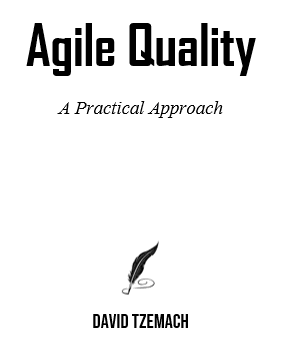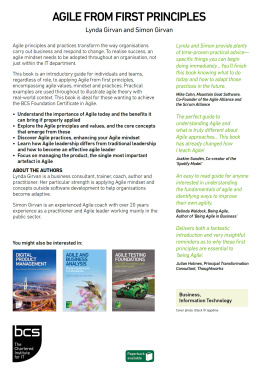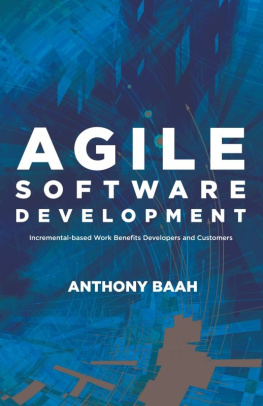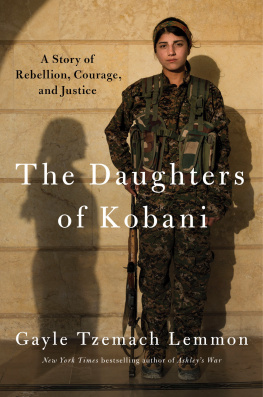Tzemach - Agile Quality: A Practical Approach
Here you can read online Tzemach - Agile Quality: A Practical Approach full text of the book (entire story) in english for free. Download pdf and epub, get meaning, cover and reviews about this ebook. year: 2020, genre: Romance novel. Description of the work, (preface) as well as reviews are available. Best literature library LitArk.com created for fans of good reading and offers a wide selection of genres:
Romance novel
Science fiction
Adventure
Detective
Science
History
Home and family
Prose
Art
Politics
Computer
Non-fiction
Religion
Business
Children
Humor
Choose a favorite category and find really read worthwhile books. Enjoy immersion in the world of imagination, feel the emotions of the characters or learn something new for yourself, make an fascinating discovery.

- Book:Agile Quality: A Practical Approach
- Author:
- Genre:
- Year:2020
- Rating:3 / 5
- Favourites:Add to favourites
- Your mark:
- 60
- 1
- 2
- 3
- 4
- 5
Agile Quality: A Practical Approach: summary, description and annotation
We offer to read an annotation, description, summary or preface (depends on what the author of the book "Agile Quality: A Practical Approach" wrote himself). If you haven't found the necessary information about the book — write in the comments, we will try to find it.
Tzemach: author's other books
Who wrote Agile Quality: A Practical Approach? Find out the surname, the name of the author of the book and a list of all author's works by series.
Agile Quality: A Practical Approach — read online for free the complete book (whole text) full work
Below is the text of the book, divided by pages. System saving the place of the last page read, allows you to conveniently read the book "Agile Quality: A Practical Approach" online for free, without having to search again every time where you left off. Put a bookmark, and you can go to the page where you finished reading at any time.
Font size:
Interval:
Bookmark:

Copyright 2020 David Tzemach.
All rights reserved. This book or any portion thereof may not be reproduced or used in any manner whatsoever without the express written permission of the publisher, except for the use of brief quotations in a book review.
Edited by Carmi Ben-Orr.
Printed in Israel.
First printing, 2020.
In a journey of almost two decades, there are just too many people that helped me to grow professionally and as a person for me to thank individually. Thanks, you changed the way I work and think and made me the person I am today.
I want to thank all of the colleagues and customers I had the privilege to work with. My expertise is all based on the challenges they provided that pushed me on the endless path of learning and innovation.
Thank you to all my friends Varonis, which I had the pleasure to work with over the last 10 years. They have always kept me on the right path and provided me with the social and professional infrastructure that has allowed me to flourish.
Special thanks are given to Liron Raveh, a dear friend who has helped by showing me how to become a better person and motivated me to break any boundaries that were holding me back, all by sharing honest and effective feedback.
Special thanks also to Gul Kanarek the person who made this book possible by giving me the inspiration and tools needed to start writing and to keep writing even in hard times.
A grateful mention also to Carmi Ben-Orr for editing this work, structuring my ideas into a concise and practical book.
Last and most important, I want to thank my beloved wife Liat and kids May, Gili and Dror who motivated me throughout the writing of this book. Without this help, I would never have come close to succeeding in this project.
David Tzemach is the author of the SupremeAgile blog, where he has written hundreds of articles on the implementation of Agile, with a focus on sustaining and improving quality.
He has been a full-time Quality Architect and Head of Quality, as well as an Agile implementation consultant, with some of the worlds best-known companies amongst his clients.
He also speaks at leading conferences about quality, implementing Agile and other subjects from the software world.
He is a proud product of the 80s and lives in Israel with his lovely wife and three amazing children.
This book reflects my own subjective opinions and the things that I have learnt on a journey of almost two decades of continuous learning. The processes, suggestions and practical examples in this book are the ones that worked for me based on my limited knowledge in specific areas.
To be clear, there are many other ways to resolve the same challenges and problems that I have encountered, solutions that in some cases will even be better than the ones I used.
To get the most from this book, I challenge you to doubt anything that I say. It's your responsibility to make sure you find your own way to handle similar challenges that are driven from the context of each individual project.
This book reflects the spirit of simplicity, which is the best way to influence and touch the reader with the hope that he will gain value from my words.
If you are familiar with my blog, you will find this book similar to the spirit I represent there. The writing is mostly practical and aimed towards the reader, with some sense of humor and examples from my own world.
This book is suitable for anyone starting a journey in the world of Agile, but also for those who have experience and need to expand their knowledge, skills and to try to use a spirit that goes beyond the boundaries of the existing rules.
In addition, the book focuses on quality in the Agile world. It will be great for anyone coming from this world (e.g. software testers, developers, architects) that wants to understand how to adapt to the Agile environment and meet the challenges they are likely to encounter.
The first few volumes of this book are about Agile and specifically about Scrum, these volumes are the basis for the rest of the book, including the advanced volumes that concentrate on quality and testing. Therefore, I suggest you read this book in order.
CONTENTS
The next few chapters provide an overview of Agile development, highlighting its core values and principles. They also review the main benefits of Agile, its challenges, and misconceptions associated with Agile software development.
Covered in this volume:
- What is Agile? Is it a framework? A mindset? A methodology?
- The core values that guide Agile teams.
- The central principles of Agile architecture.
- The main benefits of using Agile frameworks for development projects.
- The project delivery scope in the Agile environment compared to a traditional projects scope.
- What Agile release planning is
- The importance of quality in Agile projects.
- The implications of metrics in Agile.
- Common Agile myths and misconceptions.
- The main pitfalls of an Agile transition.
This chapter provides an overview of Agile and illustrates the differences between Agile software development and traditional development methodologies (e.g. waterfall and V-model).
This book is dedicated to quality in the world of Agile software development. Therefore, it is a good idea to start with a short description of Agile and its history.
Dictionary definition of agile :
- Characterized by quickness, lightness, and ease of movement; nimble.
- Mentally quick or alert: an agile mind.
The word agile describes characteristics usually related to animals and people. So, when did the term become relevant to the software development industry?
It started back in February 2001, when a group of experts in the field of software development frameworks (including Kent Beck, Mike Beedle, Robert C. Uncle Bob Martin and others) met at the Summit Lodge in Utahs Snowbird ski resort. Their main mission was to find an alternative methodology for developing products, due to frustration with the traditional methodologies in use since the early 1970s.
These traditional models, led by the waterfall model, had contributed greatly to the software industry. However, in the 1990s, these methodologies were no longer suitable due to the increasing demand for speed and high-quality of delivery, as well as the ability to adjust development to meet real customers needs.
Although the mission was clear and accepted by all participants, it was still an almost impossible task for all 17 people to agree on a single solution. However, the group did agree on four values and twelve supporting principles known as the Agile Manifesto.
The Agile Manifesto contains four core values that are used to this day as the basis of the Agile framework.
The four values are:
Font size:
Interval:
Bookmark:
Similar books «Agile Quality: A Practical Approach»
Look at similar books to Agile Quality: A Practical Approach. We have selected literature similar in name and meaning in the hope of providing readers with more options to find new, interesting, not yet read works.
Discussion, reviews of the book Agile Quality: A Practical Approach and just readers' own opinions. Leave your comments, write what you think about the work, its meaning or the main characters. Specify what exactly you liked and what you didn't like, and why you think so.





